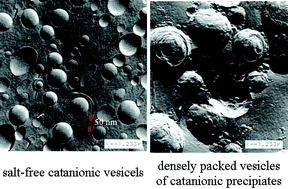Reversible phase transition between salt-free catanionic vesicles and high-salinity catanionic vesicles
Abstract
Reversible phase transition between salt-free cationic and anionic (catanionic)

* Corresponding authors
a
Key Laboratory of Colloid and Interface Chemistry (Shandong University), Ministry of Education, Jinan, P. R. China
E-mail:
jhao@sdu.edu.cn
Fax: +86 531 8836 6074
Tel: +86-531-88366074
b Universität Bayreuth, Bayreuther Zentrum fűr Kolloide und Grenzflächen, D-95446 Bayreuth, Germany
Reversible phase transition between salt-free cationic and anionic (catanionic)

 Please wait while we load your content...
Something went wrong. Try again?
Please wait while we load your content...
Something went wrong. Try again?
Y. Shen, J. Hao and H. Hoffmann, Soft Matter, 2007, 3, 1407 DOI: 10.1039/B711817A
To request permission to reproduce material from this article, please go to the Copyright Clearance Center request page.
If you are an author contributing to an RSC publication, you do not need to request permission provided correct acknowledgement is given.
If you are the author of this article, you do not need to request permission to reproduce figures and diagrams provided correct acknowledgement is given. If you want to reproduce the whole article in a third-party publication (excluding your thesis/dissertation for which permission is not required) please go to the Copyright Clearance Center request page.
Read more about how to correctly acknowledge RSC content.
 Fetching data from CrossRef.
Fetching data from CrossRef.
This may take some time to load.
Loading related content
